I Kept Fixed On Just Hearing
→ Japa Group
I kept fixed on just hearing and did not have many good japa thoughts. I was content to just occupy myself in the yajna of the sound vibration.
Satsvarupa dasa Goswami
From Bhajana Kutir #35
Websites from the ISKCON Universe
The all-digital facility is on pace to surpass 100,000 visitors in its first year.
A computer screen displays books available at BiblioTech, a first of its kind digital public library Wednesday in San Antonio. BibiloTech is the nation’s only bookless public library.
SAN ANTONIO — Texas has seen the future of the public library, and it looks a lot like an Apple Store: Rows of glossy iMacs beckon. iPads mounted on a tangerine-colored bar invite readers. And hundreds of other tablets stand ready for checkout to anyone with a borrowing card.Even the librarians imitate Apple’s dress code, wearing matching shirts and that standard-bearer of geek-chic, the hoodie. But this $2.3 million library might be most notable for what it does not have — any actual books.
That makes Bexar County’s BiblioTech the nation’s only bookless public library, a distinction that has attracted scores of digital bookworms, plus emissaries from as far away as Hong Kong who want to learn about the idea and possibly take it home.”I told our people that you need to take a look at this. This is the future,” said Mary Graham, vice president of South Carolina’s Charleston Metro Chamber of Commerce. “If you’re going to be building new library facilities, this is what you need to be doing.”All-digital libraries have been on college campuses for years. But the county, which runs no other libraries, made history when it decided to open BiblioTech. It is the first bookless public library system in the country, according to information gathered by the American Library Association.Similar proposals in other communities have been met with doubts.
In California, the city of Newport Beach floated the concept of a bookless branch in 2011 until a backlash put stacks back in the plan. Nearly a decade earlier in Arizona, the Tucson-Pima library system opened an all-digital branch, but residents who said they wanted books ultimately got their way.Graham toured BiblioTech in the fall and is pushing Charleston leaders for a bond measure in 2014 to fund a similar concept, right down to the same hip aesthetic reminiscent of Apple.Except Apple Stores aren’t usually found in parts of town like this. BiblioTech is on the city’s economically depressed South Side and shares an old strip mall with a Bexar County government building.On a recent afternoon, one confused couple walked into the library looking for the justice of the peace.
San Antonio is the nation’s seventh-largest city but ranks 60th in literacy, according to census figures. Back in the early 2000s, community leaders in Bibliotech’s neighborhood of low-income apartments and thrift stores railed about not even having a nearby bookstore, said Laura Cole, BiblioTech’s project coordinator. A decade later, Cole said, most families in the area still don’t have Wi-Fi.”How do you advance literacy with so few resources available?” she said.Residents are taking advantage now. The library is on pace to surpass 100,000 visitors in its first year.
Finding an open iMac among the four dozen at BiblioTech is often difficult after the nearby high school lets out, and about half of the facility’s e-readers are checked out at any given time, each loaded with up to five books. One of BiblioTech’s regulars is a man teaching himself Mandarin.Head librarian Ashley Elkholf came from a traditional Wisconsin high school library and recalled the scourges of her old job: misshelved items hopelessly lost in the stacks, pages thoughtlessly ripped out of books and items that went unreturned by patrons who were unfazed by measly fines and lax enforcement.But in the nearly four months since BiblioTech opened, Elkholf has yet to lend out one of her pricey tablets and never see it again.
The space is also more economical than traditional libraries despite the technology: BiblioTech purchases its 10,000-title digital collection for the same price as physical copies, but the county saved millions on architecture because the building’s design didn’t need to accommodate printed books.”If you have bookshelves, you have to structure the building so it can hold all of that weight,” Elkholf said. “Books are heavy, if you’ve ever had one fall on your foot.”Up the road in Austin, for example, the city is building a downtown library to open in 2016 at a cost of $120 million. Even a smaller traditional public library that recently opened in nearby suburban Kyle cost that city about $1 million more than BiblioTech.
On her first visit, 19-year-old Abigail Reyes was only looking for a quiet space to study for an algebra exam. But she got a quick tutorial from a librarian on how to search for digital books and check out tablets before plopping down on a row of sleek couches.”I kind of miss the books,” Reyes said. “I don’t like being on the tablets and stuff like that. It hurts my eyes.”Across the room, Rosemary Caballeo tried shopping for health insurance on a set of computers reserved for enrollment in the Affordable Care Act. Her restless 2-year-old ran around and pawed at a row of keyboards. The little girl shrieked loudly, shattering the main room’s quiet. She was soon whisked outside by her father.After all, it’s still a library.
Please click here for all photos
What is the use of the highest royal pleasures? What is the use of perfecting the yoga-system and travelling to the upper planets? What is the use of the great variety of material endeavors to attain useless ends? These things are insignificant in comparison to residence in Vrindavana. Simply by living in Vrndavana I will one day hear the sweet sound of Krishna’s flute, which brings the ultimate bliss.
(Kadamba Kanana Swami, 01 March 2012, New York, USA, Lecture)

Everything is bound by time but the maha-mantra is eternal. So many things change in our life – it’s just amazing what can change – but somehow or other, this chanting never changes. It is constant because the name is Krsna himself who descends from the spiritual world and is not bound by time; therefore this is the one constant thing in our life, the one thing that stays!
Everything else may crumble with time but this does not crumble. Rather, every time we chant the mantra, it will never be lost. Each time we chant the mantra, it piles on top of each other and just builds up. So in this way, our chanting will just gain in strength, in depth, and gradually it will take over everything. At that stage one becomes transcendental.
The Adelaide temple management organised programs every night at the temple for my last visit there. It was nice to see so many devotees attend even though the temperature outside was over 40 degrees that week. Luckily, there is air-conditioning in the temple so we danced in kirtan without feeling too hot.
- Srila Bhaktisiddhanta Saraswati Thakura, The Vedanta – Its Morphology and Ontology

On the 14th of January the Sun planet moves into Capricorn marking Uttarayana. This day is considered very auspicious by all spiritualists as this was the day chosen by Bhishma to go back to the spiritual world. On this day a big “Ganga Sagar mela” is held in Bengal where all the ancestors are given “tarpana” for their spiritual development. According to the Puranas, on this day Surya (Sun) visits the house of his son Shani (Saturn), who is the lord of the Makara rashi (Capricorn). Though the father and son duo did not get along well, the Surya made it a point to meet his son on this day. He, in fact, comes to his son's house for a month. This day thus symbolises the importance of the special relationship between father and son. Hence it is all the more auspicious.
Glories of Makara Sankranti in Scriptures:
It was on this day when Lord Vishnu ended the ever increasing terror of the asuras (demons) by finishing them off and burying their heads under the Mandara Parvata. So this occasion also represents the end of 'negativities' and beginning of an era of righteous living.
Maharaja Bhagiratha, performed great penance to bring Ganga down to the earth for the redemption of 60,000 sons of Maharaja Sagara, who were burnt to ashes at the Kapil Muni Ashramam, near the present day Ganga Sagara. It was on this day that Bhagiratha finally did tarpanawith the Ganges water for his unfortunate ancestors and thereby liberated them from the curse. After visiting the Pataala (underworld) for the redemption of the curse of Bhagiratha's ancestors the Ganges finally merged into the sea. A very big Ganga Sagara Mela is organised every year on this day at the confluence of River Ganges and the Bay of Bengal. Thousands of Hindus take a dip in the water and perform tarpanA for their ancestors
"Celebration in New Vrindaban on 14th Jan:
In New Vrindaban we have decided to hold a special “Mahayajna” for our devotees and we invite you to be a part of it. We are performing this yajna for the spiritual development of your whole family and for your ancestors. You can sponsor a yajna in the name of your family for $151. We will pray for your family. Please provide us with the names of your family members nakshatra and gotra and your beloved elders whose name you would like to add as well. You will get Narasimha Kavacha and prasada.
Cow feeding :
This day is auspicious to feed the cow with Til and Jaggery. It is said all your sins will be eradicated by feeding the cow on this day. We will do it on your behalf and we will do a cow puja as well for $108.
Brahmana Bhojana :
Brahmana Bhojana is also very important to serve the Brahmanas. Krishna eats through the brahmanas, so by sponsoring a brahamana feast on this day you will get the special blessings of all the brahmanas and they will be elevated to higher lokas. Brahmana bhojana is $501.
On the donation form there is a place to put family member names. Please put your family member names there there.
 Indradyumna Swami: Today in Thiruvananthapuram we visited a temple of Lord Parasurama, a 1,300 year old Siva temple and a Krishna temple built by Bhima 5,000 years ago. The state of Kerala is rich with the ancient culture of India. [ Photos by myself and 5 by Narottam das Thakur das ] -- Read more ›
Indradyumna Swami: Today in Thiruvananthapuram we visited a temple of Lord Parasurama, a 1,300 year old Siva temple and a Krishna temple built by Bhima 5,000 years ago. The state of Kerala is rich with the ancient culture of India. [ Photos by myself and 5 by Narottam das Thakur das ] -- Read more ›  Bondi Beach or Bondi Bay is a popular beach and the name of the surrounding suburb in Sydney, New South Wales, Australia -- Read more ›
Bondi Beach or Bondi Bay is a popular beach and the name of the surrounding suburb in Sydney, New South Wales, Australia -- Read more ›  Kavicandra Swami: This is new year harinam in OSAKA, Japan. This is one of the biggest ever. I am so happy to see the growth and the blissful faces. Bhaktin Akiyo with the accordion is a powerful preacher there. At Gaura PUrnima she will take initiation from HH Kesava Bharati Goswami -- Read more ›
Kavicandra Swami: This is new year harinam in OSAKA, Japan. This is one of the biggest ever. I am so happy to see the growth and the blissful faces. Bhaktin Akiyo with the accordion is a powerful preacher there. At Gaura PUrnima she will take initiation from HH Kesava Bharati Goswami -- Read more › The post January 6th, 2014 – Darshan appeared first on Mayapur.com.
New Vrindaban Cow Protection: Practical Necessity for a Peaceful Society
Back To Godhead Magazine, January 1976
By Vishaka devi dasi
Speaking on the troubled condition of our modern world, the late historian Arnold Toynbee once said, “The cause of it [the world's malady] is spiritual. We are suffering from having sold our souls to the pursuit of an objective which is both spiritually wrong and practically unobtainable. We have to reconsider our objective and change it. And until we do this, we shall not have peace, either amongst ourselves or within each of us.”
The conditions of our urbanized, technology-oriented society that prompted Dr. Toynbee’s remarks are no mystery to us. Especially in the West, and increasingly in the rest of the world, the mad quest for artificial luxuries has created a chaotic atmosphere pervaded by greed and power-seeking. The goal of life? “How many ways can I make money?” and “How many ways can I spend it?” The results of such a philosophy are painfully evident: internationally, we face the risk of nuclear destruction; nationally, crime waves and political corruption rule the land; and individually, we are plagued with anxiety, frustration and despair.
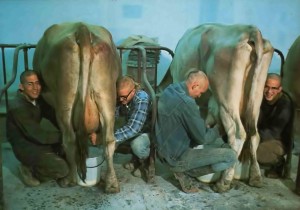
In the peaceful hill country near Moundsville, West Virginia, a sprawling thousand acre farm called New Vrindaban gives sanctuary to cows, guaranteeing them a long and happy life in return for their bountiful supply of milk. Milking the cows is a cheerful activity for the herdsmen who appreciate the animals’ good temperament.
This is the unfortunate result of a society without spiritual direction. According to the Vedic scripture Srimad-Bhagavatam, a truly peaceful, progressive society must be based on service to God. Such a spiritually evolved civilization actually flourished on this planet five thousand years ago and the people were rich in both spiritual and material assets. The Supreme Lord was pleased with the service rendered by the citizens, and thus He profusely supplied the necessities of life milk, food grains, fruits, vegetables, silk, cotton, minerals and jewels. Being fully satisfied spiritually, people did not look for pleasure in artificial sensual stimulation indulged in at the cost of health and sanity. People lived simply, close to nature and close to God free of the encumbrances of a modern mechanistic civilization. Dwelling on tracts of land suitable for complete self-sufficiency, Vedic agricultural families used all the resources at hand. Because the cows were treated very affectionately and protected from any harm, they were very joyful and secure. Thus, they contributed much greater amounts of milk than today’s animals. The very valuable cow dung was used not only as a fertilizer but also as a heating and cooking fuel, and even as a cleanser. (Modern science has confirmed the disinfectant properties of cow dung.) And bulls provided the muscle for plowing and harvesting the fields, milling the grain, and pulling oxcarts full of people and commodities.
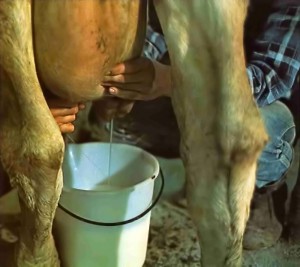
Jets of warm milk squirt into a bucket from a cow’s generous udder. Buckets are then poured into ten-gallon cans. On a good day, a Holstein fills up one can with eighty pounds of milk.
Accustomed as we are to modern conveniences, we may regard such a life as primitive and far from ideal. However, when the Supreme Lord Sri Krsna appeared on this planet five thousand years ago, He showed by His own example that for both material prosperity and spiritual advancement, human civilization must maintain the cow and bull very carefully.
At New Vrindaban, ISKCON’s Vedic village near Moundsville, West Virginia, Lord Krsna’s example is being put into practice. Established by His Divine Grace Srila Prabhupada nine years ago, New Vrindaban now spreads over one thousand acres of hilly farmland and is a perfect example of the benefits derived from organizing society according to the principles of cow protection and service to Krsna. Kirtanananda Swami, leader of the New Vrindaban community, describes the project’s purpose: “It is a great vision of presenting to everyone, not only in this country but in the whole world, how one can become Krsna conscious living just as Krsna lived in Vrindaban, depending on nature and the cows.”
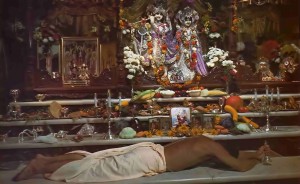
A devotee offers dairy foods and a variety of the farm’s harvest to please Lord Krishna on the altar at New Vrindaban.
The following is a conversation between BTG staff photographer Visakha-devi dasi and two cowherd men of New Vrindaban.
Visakha dasi: You seem to enjoy working with cows very much. Can you tell us why?
Ambarisa dasa: The cows here at New Vrindaban are special. You can sense this immediately when you come in contact with them. They’re Krsna’s cows. They’re very dear to Krsna, and when you work with them it’s easy to remember Him. They’re mellow and their temperament reflects on you.
You have to approach them with an attitude of service. By relating to them on a personal basis and serving them with a humble attitude, you can see them as living beings with feelings and personalities. Most farmers raise cows with a dollar sign in their mind. It’s very impersonal. Regular dairy farmers or ranchers use the cow as a machine or a tool for their own selfish ends. It’s very gross. But when we serve Krsna’s cows, we realize that each one has a specific personality.
Visakha dasi: Why do you say that these cows at New Vrindaban are Krsna’s cows? Aren’t all the cows everywhere Krsna’s cows?
Ambarisa dasa: Yes, but these cows are special. They belong to Krsna even more because they’re serving Krsna more. That is, their milk is being offered to Krsna in the temple here. That’s why we take so much trouble with them. Because the milk they give is for the pleasure of Lord Krsna. Also, these cows are happier than cows on other farms. Most farmers send their cows to the slaughterhouse when they get to be a certain age. The cows know they’re going to be slaughtered they can sense it. They seem very sad, so they’re less attractive. But our cows know they’re not going to be slaughtered they know they’re being protected. They’re a lot happier, and they give lots of milk.
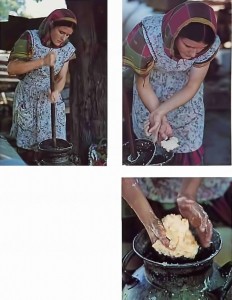
Every day at four P.M., the cream from the day’s two milkings is churned into butter by Viduttama dasi. Inside the can, the rod she holds is attached to a round wooden disc with a sawtoothed edge. When the rod is moved up and down, the disc churns the cream into a rich, light-colored butter.
Visakha dasi: What’s your daily routine?
Ganendra dasa: One of the best things about working with cows is that your life becomes well regulated. We get up at two in the morning to milk the cows. It’s very nice because we know we’re doing it just to please Lord Krsna. It puts us right on the transcendental plane first thing in the day.
The schedule fits in nicely with our temple routine. We milk the cows at two o’clock, and as soon as we’re done milking, we go into the temple and attend the morning functions. We’re busy all the time this way, and we don’t fall down to a mundane level. The early morning hours are the best time for spiritual practice.
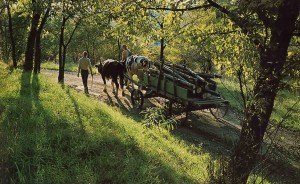
Afternoon sun streams through late summer foliage as an ox team hauls logs for winter firewood out of the forest. Bulls are needed as much as cows in a Vedic community; besides hauling, they plow the fields, grind the grains, and provide transportation. The trio of bulls, cows and land forms the central structure of Vedic economy.
Ambarisa dasa: Cows are the most regulated animals I know. They eat at a certain time, are milked at a certain time, go out to the fields at a certain time, walk so many hours a day, chew their cud for so many hours a day. Their bodies function on a tight schedule, and whenever this schedule is upset even a little bit, they immediately let you know. So you have to be really fixed in your duty. You have to think, “If I don’t milk the cows, they’ll get sick, and then they won’t give any milk.” The devotees who are cooking the food that gets offered to Krsna are thinking the same thing “If I don’t cook this offering for Krsna, then He won’t get anything to eat.” The consciousness is very personal, very nice.
Ganendra dasa: It’s just like with people. There’s always an exchange of feelings. Since the cow is a person too, when we become friendly toward them, each cow responds personally. That’s how cows are the more affectionate you are to them, the more affectionate they are to you. They give more milk and are happier.
Ambarisa dasa: That’s one thing about New Vrindaban. All the animals here are free from anxiety, and anyone who comes here feels that and also becomes free from anxiety. Recently a newspaper reporter visited us, and he wrote in his article that when you’re at New Vrindaban you may not realize how free from the mundane rat race you are, but as soon as you go back you understand that you’ve been in a transcendental place.
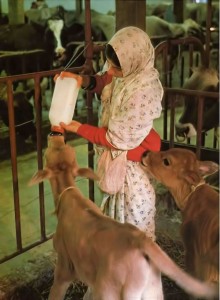
Feeding the calves half gallons of milk at a time, Vijaya dasi fills in for the mother cows. When feeding directly from their mothers, calves often get sick from their inevitable overindulgence. For cows, calves and bulls to live happily, human beings must protect them.
Visakha dasi: Do you think it’s practical to put so much emphasis on the cow?
Ganendra dasa: Well, we’ve seen here that cows actually can support human society materially and spiritually. In fact, that’s the purpose of the cow. They give more milk than their calves can drink. So the extra milk is meant for us it helps us develop a good brain for understanding spiritual life. Also, she supplies pure cow dung that can be recycled into the fields to cultivate the grains and the pastures. And the bull helps till the fields. In this way a perfect cycle is maintained. We cultivate crops on land fertilized with manure; then we offer the food to Lord Krsna: Krsna eats sumptuously, we eat sumptuously, the cows eat sumptuously, and everyone is satisfied.
On the other hand, slaughtering the cow is detrimental to everyone. The meat is harmful to your body and your brain. And the cow has been caused much pain, so there are great sinful reactions to suffer. If you protect the cows, give them what they want, and derive the benefits in the way Krsna intended, then when they die of their own accord you can use the skin for leather, if necessary. But you don’t have to kill cows.
The Srimad-Bhagavatam says the cow is an offenseless living being. It’s Krsna’s arrangement that the cow takes so little and gives so much. From her milk you can make hundreds of delicious preparations. She simply performs her service very peacefully without any bother to anyone. These are the qualities of an ideal devotee, and they’re reflected on those who work with the cows.
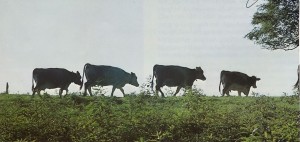
A local West Virginia newspaper recently called New Vrindaban’s 120 cows “one of the best dairy herds in the state.”
Snana Yatra 2013 Part 1 Melbourne

 Govardhan, in his role as a devotee, is just ecstatically running towards Krsna, believe it or not! For the skeptics, what can I say? For the cynics, there are clinics… (smile)
Govardhan, in his role as a devotee, is just ecstatically running towards Krsna, believe it or not! For the skeptics, what can I say? For the cynics, there are clinics… (smile)
For the devotee, life is a miracle. And this is what Prabhupada said about miracles, “Miracles don’t exist! It is simply that we don’t understand.
So miracles don’t exist. Why is something a miracle? When we’re dealing with Krsna, the unlimited Supreme Lord, are we saying there is something that Krsna cannot do? What is a miracle for Krsna? He’s not limited!
So do you think that Govardhan cannot run? Watch out next time you’re on Govardhan parikrama!
Please click here for all photos
May I love Vrndavana, where at the base of a kadamba tree on the cool shore of the Yamuna a dark complexioned, amorous, divine youth dressed in yellow garments plays a flute as He glances at Radha’s lotus face.
[Source : Nectarean Glories of Sri Vrindavana-dhama by Srila Prabodhananda Sarasvati Thakura, 1-27 Translation ]